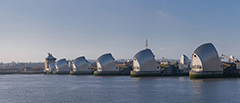Levees
A levee is an elongated naturally occurring ridge or artificially constructed fill or wall, which regulates water levels. It is usually earthen and often parallel to the course of a river in its floodplain or along low-lying coastlines.
 The main purpose of artificial levees is to prevent flooding of the adjoining countryside and to slow natural course changes in a waterway to provide reliable shipping lanes for maritime commerce over time; they also confine the flow of the river, resulting in higher and faster water flow. Levees can be mainly found along the sea, where dunes are not strong enough, along rivers for protection against high-floods, along lakes or along polders. Furthermore, levees have been built for the purpose of empoldering, or as a boundary for an inundation area. The latter can be a controlled inundation by the military or a measure to prevent inundation of a larger area surrounded by levees. Levees have also been built as field boundaries and as military defences. More on this type of levee can be found in the article on dry-stone walls.
The main purpose of artificial levees is to prevent flooding of the adjoining countryside and to slow natural course changes in a waterway to provide reliable shipping lanes for maritime commerce over time; they also confine the flow of the river, resulting in higher and faster water flow. Levees can be mainly found along the sea, where dunes are not strong enough, along rivers for protection against high-floods, along lakes or along polders. Furthermore, levees have been built for the purpose of empoldering, or as a boundary for an inundation area. The latter can be a controlled inundation by the military or a measure to prevent inundation of a larger area surrounded by levees. Levees have also been built as field boundaries and as military defences. More on this type of levee can be found in the article on dry-stone walls.
Levees can be permanent earthworks or emergency constructions (often of sandbags) built hastily in a flood emergency. When such an emergency bank is added on top of an existing levee it is known as a cradge. More details
 The main purpose of artificial levees is to prevent flooding of the adjoining countryside and to slow natural course changes in a waterway to provide reliable shipping lanes for maritime commerce over time; they also confine the flow of the river, resulting in higher and faster water flow. Levees can be mainly found along the sea, where dunes are not strong enough, along rivers for protection against high-floods, along lakes or along polders. Furthermore, levees have been built for the purpose of empoldering, or as a boundary for an inundation area. The latter can be a controlled inundation by the military or a measure to prevent inundation of a larger area surrounded by levees. Levees have also been built as field boundaries and as military defences. More on this type of levee can be found in the article on dry-stone walls.
The main purpose of artificial levees is to prevent flooding of the adjoining countryside and to slow natural course changes in a waterway to provide reliable shipping lanes for maritime commerce over time; they also confine the flow of the river, resulting in higher and faster water flow. Levees can be mainly found along the sea, where dunes are not strong enough, along rivers for protection against high-floods, along lakes or along polders. Furthermore, levees have been built for the purpose of empoldering, or as a boundary for an inundation area. The latter can be a controlled inundation by the military or a measure to prevent inundation of a larger area surrounded by levees. Levees have also been built as field boundaries and as military defences. More on this type of levee can be found in the article on dry-stone walls.Levees can be permanent earthworks or emergency constructions (often of sandbags) built hastily in a flood emergency. When such an emergency bank is added on top of an existing levee it is known as a cradge. More details
